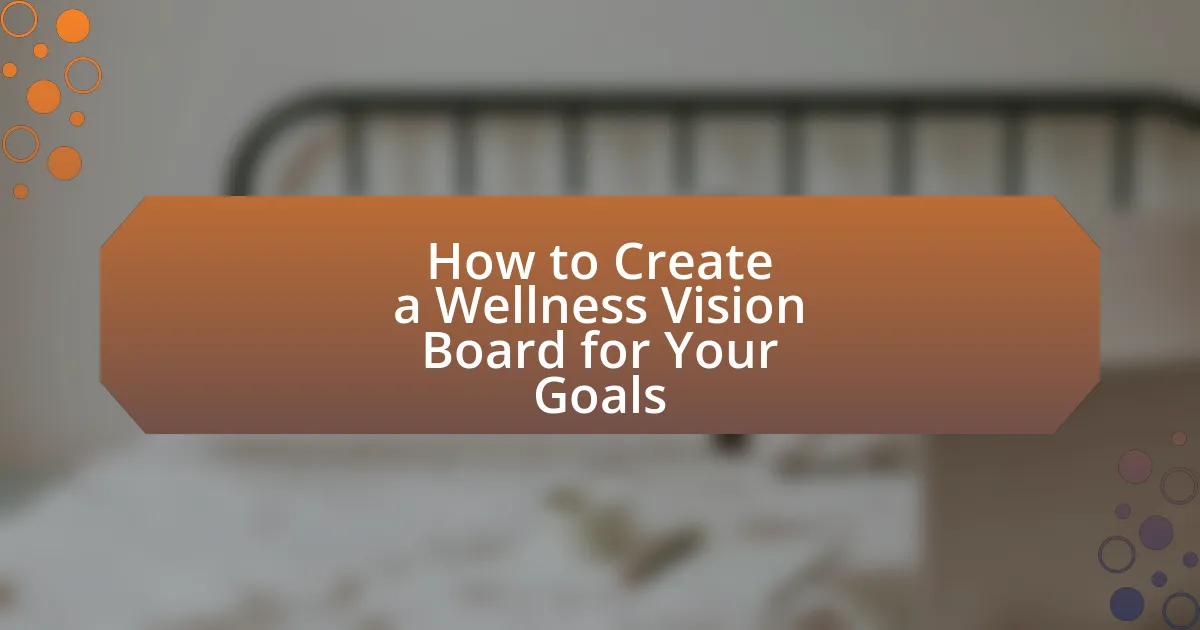A Wellness Vision Board is a visual tool that represents an individual’s health and wellness goals, incorporating images, quotes, and affirmations to inspire motivation and focus. This article outlines the process of creating an effective Wellness Vision Board, emphasizing the importance of defining clear wellness goals, selecting meaningful visuals, and regularly updating the board to reflect evolving aspirations. It also discusses the psychological benefits of visualization techniques in enhancing goal achievement, promoting mindfulness, and maintaining motivation throughout one’s wellness journey. Key elements, materials needed, and best practices for integrating the vision board into daily routines are also covered, providing a comprehensive guide for individuals seeking to manifest their wellness objectives.

What is a Wellness Vision Board?
A Wellness Vision Board is a visual representation of an individual’s health and wellness goals, designed to inspire and motivate. It typically includes images, quotes, and affirmations that reflect personal aspirations related to physical, mental, and emotional well-being. Research indicates that visualization techniques, such as those used in vision boards, can enhance goal achievement by reinforcing positive thinking and focus, as supported by studies in psychology that highlight the effectiveness of visual cues in goal setting and motivation.
How does a Wellness Vision Board help in achieving goals?
A Wellness Vision Board helps in achieving goals by providing a visual representation of aspirations and intentions, which enhances focus and motivation. This tool allows individuals to clarify their wellness objectives, such as physical health, mental well-being, and personal growth, by incorporating images and affirmations that resonate with their desired outcomes. Research indicates that visualization techniques, like those used in vision boards, can significantly improve goal attainment by reinforcing positive thinking and commitment to action. For instance, a study published in the Journal of Personality and Social Psychology found that individuals who visualize their goals are more likely to take steps toward achieving them, as the process strengthens neural pathways associated with those goals.
What are the key elements of a Wellness Vision Board?
The key elements of a Wellness Vision Board include clear goals, visual representations, affirmations, and a focus on holistic well-being. Clear goals define specific areas of wellness such as physical health, mental clarity, emotional balance, and spiritual growth. Visual representations, such as images and symbols, serve as reminders of these goals and inspire motivation. Affirmations are positive statements that reinforce the desired mindset and encourage self-belief. Lastly, a focus on holistic well-being ensures that the vision board encompasses all aspects of life, promoting a balanced approach to wellness. These elements collectively create a powerful tool for manifesting wellness aspirations.
How can visualization enhance goal achievement?
Visualization enhances goal achievement by creating a mental image of success, which can increase motivation and focus. Research indicates that visualizing goals activates the same neural pathways as actually performing the tasks, making individuals more likely to take the necessary actions to achieve those goals. A study published in the Journal of Applied Psychology found that participants who engaged in visualization techniques were more successful in achieving their goals compared to those who did not. This demonstrates that visualization not only clarifies objectives but also reinforces commitment and enhances performance.
Why is creating a Wellness Vision Board important?
Creating a Wellness Vision Board is important because it serves as a visual representation of personal health and wellness goals, enhancing motivation and focus. Research indicates that visualizing goals can significantly increase the likelihood of achieving them; a study published in the Journal of Personality and Social Psychology found that individuals who visualize their goals are more likely to take actionable steps towards them. By regularly interacting with a Wellness Vision Board, individuals reinforce their commitment to their wellness journey, making it a powerful tool for personal growth and accountability.
What psychological benefits does a Wellness Vision Board provide?
A Wellness Vision Board provides several psychological benefits, including enhanced motivation, increased clarity of goals, and improved emotional well-being. By visually representing aspirations and wellness objectives, individuals experience heightened motivation to pursue their goals, as the board serves as a constant reminder of their desired outcomes. Research indicates that visualization techniques, such as those employed in creating vision boards, can significantly boost motivation and goal attainment (Taylor, S. E., & Schneider, S. K., 1989, “Coping with Life Stress: The Role of Social Support”). Additionally, the process of creating a vision board fosters clarity by helping individuals articulate and prioritize their wellness goals, which can lead to more focused actions. Lastly, engaging with a vision board can enhance emotional well-being by promoting positive thinking and reducing stress, as individuals visualize their ideal selves and futures.
How does a Wellness Vision Board promote mindfulness?
A Wellness Vision Board promotes mindfulness by visually representing personal goals and aspirations, which encourages focused attention on one’s intentions. This practice fosters a deeper connection to the present moment, as individuals actively engage with their desires and values through imagery and affirmations. Research indicates that visualization techniques, such as those used in creating vision boards, can enhance self-awareness and emotional regulation, contributing to a mindful state. By regularly interacting with the board, individuals reinforce their commitment to wellness, thereby cultivating a habit of mindfulness in daily life.

How do you create a Wellness Vision Board?
To create a Wellness Vision Board, start by gathering materials such as a poster board, magazines, scissors, and glue. Next, define your wellness goals, which may include areas like physical health, mental well-being, and emotional balance. After identifying your goals, search for images and words in magazines that resonate with your aspirations and represent your desired outcomes. Arrange these visuals on the board in a way that feels inspiring and motivating to you, ensuring that they reflect your personal vision of wellness. Finally, place your completed vision board in a visible location to serve as a daily reminder of your goals and intentions. This method is effective as visual representation can enhance motivation and focus, aligning with research that shows visualization techniques can improve goal achievement.
What materials do you need to create a Wellness Vision Board?
To create a Wellness Vision Board, you need poster board or a corkboard as the base, magazines or printed images for visuals, scissors for cutting, glue or push pins for attaching items, and markers for writing affirmations or goals. These materials allow for a personalized and visually appealing representation of wellness goals, facilitating motivation and focus. The use of visual elements is supported by research indicating that visualizing goals can enhance motivation and goal achievement.
What types of images and words should you include?
Include images that represent health, happiness, and personal growth, such as nature scenes, fitness activities, and inspirational figures. Words should be positive affirmations, goal-oriented phrases, and motivational quotes that resonate with your wellness aspirations. Research indicates that visual stimuli can enhance motivation and goal clarity, making the selection of relevant images and words crucial for effective vision boards.
How can you personalize your Wellness Vision Board?
To personalize your Wellness Vision Board, identify specific wellness goals that resonate with your values and aspirations. This involves selecting images, quotes, and symbols that reflect your unique journey towards health, happiness, and balance. Research indicates that visual representation of goals can enhance motivation and commitment, as seen in studies on visualization techniques in psychology. By curating elements that inspire you personally, such as favorite activities, affirmations, or role models, you create a board that serves as a daily reminder of your individual wellness path.
What steps should you follow to create an effective Wellness Vision Board?
To create an effective Wellness Vision Board, begin by defining your wellness goals, which can include physical health, mental well-being, and emotional balance. Next, gather materials such as a board, magazines, scissors, and glue to visually represent these goals. Then, select images and words that resonate with your aspirations, ensuring they align with your defined wellness objectives. After that, arrange these visuals on the board in a way that inspires you, creating a cohesive and motivating layout. Finally, place your completed vision board in a visible location to serve as a daily reminder of your wellness goals, reinforcing your commitment to achieving them. This structured approach is supported by the concept that visual representation can enhance motivation and goal attainment, as evidenced by studies in psychology that highlight the effectiveness of visualization techniques in achieving personal objectives.
How do you define your wellness goals before starting?
To define wellness goals before starting, individuals should assess their current health status, identify specific areas for improvement, and set measurable objectives. This process involves evaluating physical, mental, and emotional well-being, which can be supported by tools such as health assessments or self-reflection exercises. Research indicates that setting SMART (Specific, Measurable, Achievable, Relevant, Time-bound) goals enhances the likelihood of achieving desired outcomes, as evidenced by a study published in the American Journal of Lifestyle Medicine, which found that structured goal-setting significantly improves health behaviors and outcomes.
What is the process of assembling your Wellness Vision Board?
The process of assembling your Wellness Vision Board involves several key steps. First, gather materials such as a board, magazines, scissors, glue, and markers. Next, reflect on your wellness goals, identifying specific areas like physical health, mental well-being, and personal growth. After defining your goals, search for images and words in magazines that resonate with these aspirations. Cut out these visuals and phrases, then arrange them on the board in a way that feels inspiring to you. Finally, glue the pieces down and place your completed board in a visible location to serve as a daily reminder of your wellness objectives. This method is effective as visual representation can enhance motivation and focus on achieving personal goals.

What are some tips for maintaining your Wellness Vision Board?
To maintain your Wellness Vision Board effectively, regularly review and update it to reflect your evolving goals and aspirations. This practice ensures that the board remains relevant and motivating, as research indicates that visual reminders can significantly enhance goal achievement. Additionally, setting aside time each month to assess your progress and make adjustments fosters a proactive approach to your wellness journey. Engaging with the board daily, whether through visualization or affirmations, reinforces your commitment and keeps your objectives at the forefront of your mind.
How often should you review and update your Wellness Vision Board?
You should review and update your Wellness Vision Board at least once every month. Regular monthly reviews allow you to assess your progress towards your wellness goals, make necessary adjustments, and stay motivated. Research indicates that frequent reflection on personal goals enhances commitment and increases the likelihood of achieving them, as noted in studies on goal-setting theory.
What strategies can help keep you motivated with your Wellness Vision Board?
To stay motivated with your Wellness Vision Board, regularly review and update it to reflect your evolving goals and aspirations. This practice reinforces your commitment and keeps your vision fresh, making it more relevant to your current life circumstances. Research indicates that visual reminders can significantly enhance motivation and goal achievement; for instance, a study published in the Journal of Personality and Social Psychology found that individuals who visualize their goals are more likely to take action towards achieving them. Additionally, setting specific, measurable milestones related to your vision board can provide a sense of accomplishment and further motivate you to pursue your wellness objectives.
What common mistakes should you avoid when creating a Wellness Vision Board?
Common mistakes to avoid when creating a Wellness Vision Board include lack of clarity in goals, using vague images or words, and failing to update the board regularly. Clarity in goals is essential because specific objectives guide the visualization process, making it more effective. Vague images or words can lead to confusion and dilute the intended message, reducing motivation. Additionally, not updating the board can result in stagnation, as personal goals and aspirations may evolve over time, necessitating adjustments to reflect current desires and priorities.
How can unrealistic expectations affect your Wellness Vision Board?
Unrealistic expectations can significantly hinder the effectiveness of your Wellness Vision Board by creating feelings of disappointment and discouragement. When individuals set unattainable goals, they may become overwhelmed and lose motivation, leading to a lack of engagement with their vision board. Research indicates that setting realistic and achievable goals is crucial for maintaining motivation and satisfaction; for instance, a study published in the Journal of Personality and Social Psychology found that individuals who set specific, attainable goals were more likely to achieve them compared to those with vague or overly ambitious objectives. Therefore, unrealistic expectations can derail the purpose of a Wellness Vision Board, which is to inspire and guide individuals toward achievable wellness goals.
What should you do if your goals change over time?
If your goals change over time, you should reassess and realign your wellness vision board to reflect your new objectives. This involves evaluating your current goals, identifying what has shifted, and updating the visual elements on your board to inspire and motivate you towards these new aspirations. Research indicates that regularly updating personal goals can enhance motivation and focus, as seen in studies on goal-setting theory, which emphasize the importance of aligning goals with current values and circumstances for optimal success.
What are some best practices for using a Wellness Vision Board effectively?
To use a Wellness Vision Board effectively, individuals should regularly update it to reflect evolving goals and aspirations. This practice ensures that the board remains relevant and motivating, aligning with personal growth and changes in wellness priorities. Additionally, placing the vision board in a visible location reinforces daily engagement and serves as a constant reminder of one’s wellness objectives. Research indicates that visual reminders can enhance motivation and goal achievement, as seen in studies on visualization techniques in psychology. Regularly reviewing and interacting with the board can also deepen commitment to wellness goals, making the vision board a dynamic tool for personal development.
How can you integrate your Wellness Vision Board into your daily routine?
To integrate your Wellness Vision Board into your daily routine, place it in a visible location where you will see it regularly, such as your workspace or bedroom. This visibility serves as a constant reminder of your wellness goals and aspirations. Additionally, allocate specific times each day to engage with the board, such as during morning routines or evening reflections, allowing you to visualize your goals and assess your progress. Research indicates that visual cues can significantly enhance motivation and goal achievement, as demonstrated in studies on visualization techniques in psychology. By consistently interacting with your Wellness Vision Board, you reinforce your commitment to your wellness journey and increase the likelihood of achieving your goals.
What role does reflection play in the effectiveness of a Wellness Vision Board?
Reflection is crucial for the effectiveness of a Wellness Vision Board as it allows individuals to assess their goals, motivations, and progress. Engaging in reflection helps clarify what aspects of wellness are most important, enabling a more focused and personalized vision board. Studies indicate that reflective practices enhance goal-setting and achievement by fostering self-awareness and accountability, which are essential for maintaining motivation and commitment to wellness objectives.
